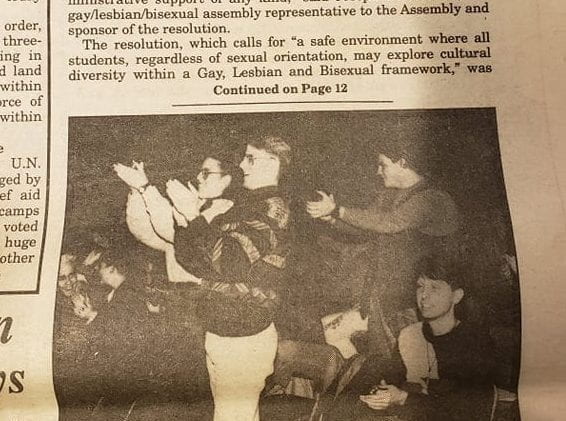by Deeps Ilango, Class of 2022, Government and American Studies
The three news clips below reveal the history of the fight by the Cornell University Student Assembly – specifically LGBTQ+ Representative Jose Barrios – to create better living conditions for queer students on campus. In December 1992, and again in March 1993, the Student Assembly passed two resolutions calling on the administration to both update existing family housing policy to exclude marital status from consideration – a move that would open up housing to gay couples – and to create an entirely new LGBTQ+ living center on campus. These resolutions were fiercely fought against by many conservative voices, like then Cornell President Frank Rhodes.
This debate took place during a politically tumultuous time at Cornell, as students of color rallied to carve out academic and cultural niches for themselves on an overwhelmingly white campus. Within queer circles, this move towards student militancy had been solidifed by the formation of the Gays, Bisexuals, and Lesbians of Color (GLBOC) nearly a decade ago. In this climate, Joseph Barrios emerged as both a queer and Latino voice on the Student Assembly.
In a very public confrontation, Barrios persuaded the Student Assembly to pass the resolution in December of 1992. Facing off against various opponents, his proposal was successful, only to be dismissed out of hand by then President Rhodes. In light of Barrios’ claim in the Daily Sun that “gays on this campus are sick and tired of … homophobia with absolutely no administrative support of any kind,” Rhodes’ dismissal served as a rallying point for queer campus activists.
Amidst growing student unrest in the spring of 1993, when the Student Assembly again decided to reaffirm their commitment to Barrios’ resolution in an 11-7 vote, Rhodes knew he had to concede to at least one of the demands. Cornell had been thrust into the national spotlight as the first Ivy League institution to face this issue, and so under the eyes of the watching world, Cornell announced a huge step forward for queer advocacy on campus in April of 1993 by updating its family housing policy. The Ithaca Journal reported that Rhodes “was not endorsing the resolution” itself however, and no concession was made in terms of a new living center.
And yet its spirit lived on. Nearly 25 years after that decision, Cornell decided to finally implement an LGBTQ+ specific living center – the Loving House – as part of a planned expansion to North Campus. By housing 30 students every year, it stands as a testament to the queer student activism on campus that preceded it.
Sources
Ehtasham, Aelya. S.A. passes resolution calling for implementation of Queer-Inclusive Program House. The Cornell Daily Sun. November 16, 2017.
Joseph L. Barrios Papers, #7784. Division of Rare and Manuscript Collections, Cornell University Library.
Kakutani, Yuichiro, and Meredith Liu. “Cornell to establish LGBTQ program house 25 years after initial proposal.” The Cornell Daily Sun. March 1, 2018.
Rabin, Roni. “Gays At Cornell May Get Separate Dorm, After All.” The Seattle Times. March 14, 1993.
Skelton, Diana. “Gays, Lesbians of Color Rally, Discuss Oppressions, Tactics,” Cornell Daily Sun. April 14, 1986. Web.
Deeps Ilango, who graduated from Cornell in 2022 with majors in Government and American Studies, is very passionate about the intersection between diaspora and queer histories.



